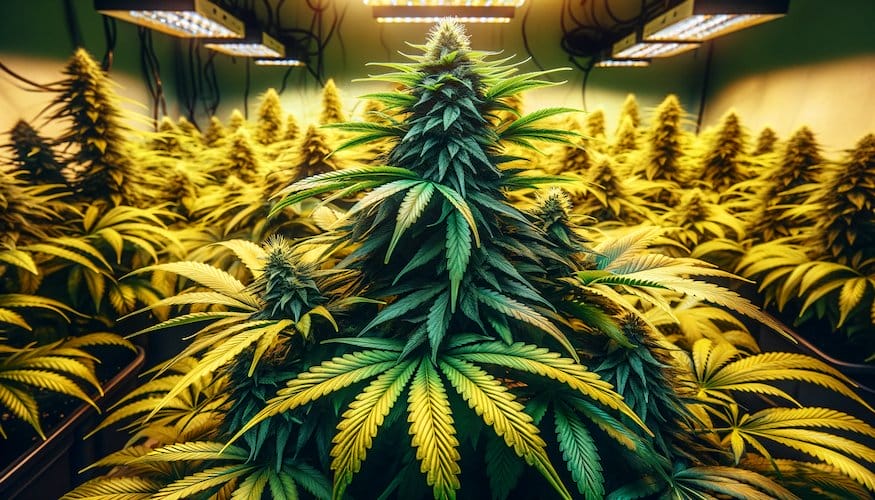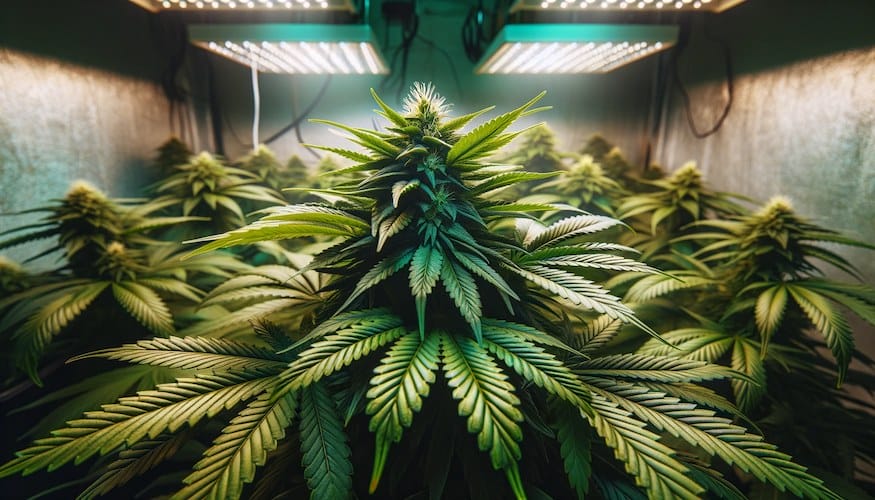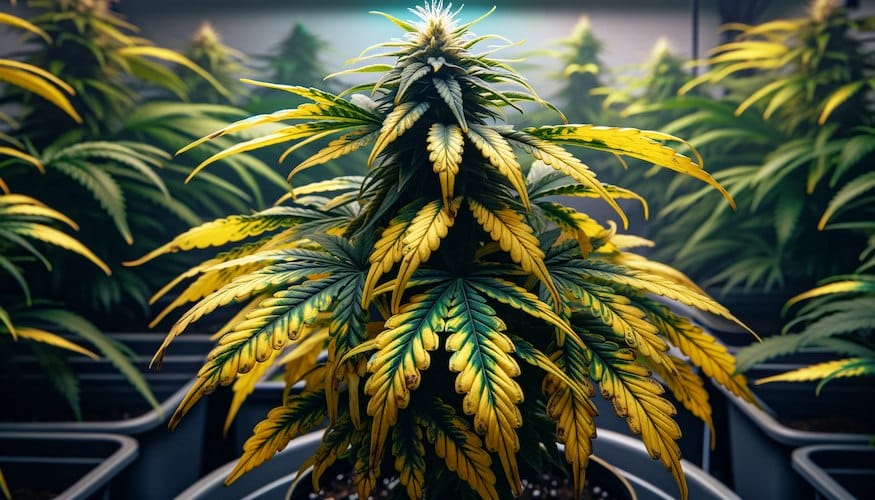Cannabis Micronutrients: Essential Plant-Growth Guide

For those immersed in cannabis cultivation, understanding the pivotal role of cannabis micronutrients is paramount to nurturing robust growth and sustaining cannabis plant health. Just as a gourmet chef masters the delicate balance of flavors, a cannabis grower must navigate the intricate world of plant nutrition. This guide dives deep into the necessity of optimizing cannabis micronutrient uptake to ensure your plants flourish. From essential trace elements to preventing nutrient deficiencies, we uncover the secrets to vibrant and vigorous cannabis plants.
Join us on a journey through the essentials of cannabis nutrition; think of it as a botanical buffet where every micronutrient is a key ingredient to a thriving harvest. Let the cultivation commence!
Key Takeaways
- Delve into the significance of cannabis micronutrients for impeccable plant growth.
- Learn strategies to enhance the uptake of vital micronutrients, promoting peak plant wellness.s
- Discover the intricate dance between macronutrients and micronutrients for balanced nourishme.nt
- Uncover the common hurdles in cannabis nutrition—avoiding deficiencies and over-supplementation
- Grasp the impact of pH levels on nutrient absorption and overall plant vital.ity
Understanding the Vital Role of Cannabis Micronutrients
In the realm of cannabis cultivation, the vibrant health and bounty of the harvest hinge on understanding the subtle yet essential micronutrients for cannabis. Despite their necessity in trace amounts, these elements play a pivotal role in cannabis growth, influencing everything from the plant’s cellular structure to the eventual potency of the buds.
What Are Micronutrients and Why Are They Important?
Micronutrients, though needed in minute concentrations compared to their macronutrient counterparts, are crucial for the intricate physiological processes in cannabis plants. They aid in critical functions such as chlorophyll production, resistance to pests, and regulating growth hormones.
The Distinction Between Macronutrients and Micronutrients
Macronutrients, such as nitrogen, phosphorus, and potassium, are often spotlighted for their roles in plant nutrition, yet micronutrients, which include elements like boron, copper, and iron, are just as vital for maintaining healthy growth. The balance between these nutrient groups is key—an overemphasis on one can lead to deficiencies in the other, disrupting plant development.
Detecting Micronutrient Deficiencies in Cannabis Plants
One of the most challenging aspects of cannabis cultivation is identifying and rectifying cannabis nutrient deficiency symptoms. These deficiencies can present themselves in various ways, from discoloration to distorted leaf growth, often signaling a need for intervention and adjustment in the micronutrient regimen.
| Micronutrient | Deficiency Symptoms | Function in Cannabis Growth |
|---|---|---|
| Boron | Thickening of shoot tips, brittle leaves | Cell wall formation and reproductive growth |
| Copper | Dark green leaves, often with a blue-purple tinge | Chlorophyll production and metabolism |
| Iron | Yellowing of young leaves while the veins remain green | Essential for chlorophyll synthesis |
| Manganese | Interveinal chlorosis, necrosis, and reduced growth rates | Enzyme activation for photosynthesis and nitrogen assimilation |
| Molybdenum | Yellowing of middle leaves and distorted leaf growth | Nitrogen fixation and conversion of nitrates |
| Zinc | Stunted growth with small, distorted leaves | Hormone regulation and internode elongation |
Identifying Key Cannabis Plant Nutrients for Optimal Growth
Achieving robust growth in cannabis cultivation hinges on a comprehensive nutrient strategy that understands the synergetic importance of both macro and micro-nutrient components. This section delves into the fundamental role of cannabis macronutrients. It underscores the importance of micronutrients in cannabis cultivation, setting the stage for a thriving harvest while guarding against potential micronutrient deficiencies in cannabis plants.
The Necessity of Nitrogen, Phosphorus, and Potassium (NPK)
Nitrogen (N), phosphorus (P), and potassium (K)—collectively known as NPK—are the backbone of cannabis nutrition. Each serves a critical role in plant development: Nitrogen spurs vigorous vegetative growth, phosphorus is essential for root development and flowering, while potassium aids in the overall functions of plant operation, including water uptake, enzyme activation, and photosynthesis.
Secondary Nutrients: The Supporting Players in Plant Health
While primary macronutrients may headline the nutrient regime narrative, secondary elements such as calcium, magnesium, and sulfur perform crucial, supporting roles. These nutrients aid in functional and structural tasks, from fortifying cell walls to synthesizing critical enzymes and chlorophyll. The balanced interaction between these secondary nutrients and primary NPK ratios is fundamental in reinforcing the plant’s overall vigor and resilience against stress.
| Nutrient | Role | Deficiency Symptom |
|---|---|---|
| Nitrogen (N) | Vital for vegetative growth, protein synthesis, and chlorophyll formation. | Pale green to yellow leaves, starting with the lower foliage. |
| Phosphorus (P) | Supports root development, energy storage and transfer, and flower maturation. | Dark green foliage with a potential for a purplish tint, stunted growth. |
| Potassium (K) | Serves in enzyme activation, water regulation, and disease resistance. | Brown scorching and curling of leaf tips, yellowing between leaf veins. |
| Calcium (Ca) | Integral for cell wall structure, permeability, and growth. | New growths are distorted or irregular, with potential for blossom end rot in fruits. |
| Magnesium (Mg) | Central component of chlorophyll, essential for photosynthesis. | Veins remain green while areas in between show yellowing. |
| Sulfur (S) | Essential for amino acids, enzymes, and proteins. | Younger leaves turn yellow first, and there is a slower growth rate. |
Essential Micronutrients for Cannabis Explained
A balanced nutrient regime for cannabis is not just about the primary macronutrients; the best micronutrients play a pivotal role in the plant’s life cycle. These elements, though needed in smaller amounts, are critical for the cultivation of healthy cannabis plants. This section dives into the importance of various trace elements, including boron, chlorine, copper, iron, manganese, molybdenum, and zinc, as they contribute to various plant functions vital to growth and health.
| Micronutrient | Function | Significance During Stage |
|---|---|---|
| Boron (B) | Essential for cell wall formation and improves cell division | Both vegetative and flowering |
| Chlorine (Cl) | Aids in osmosis and ionic balance | Vegetative |
| Copper (Cu) | Key for photosynthesis and enzyme activities | Vegetative and flowering |
| Iron (Fe) | Crucial for chlorophyll synthesis and energy transfer | Vegetative, especially in young plants |
| Manganese (Mn) | Involved in enzyme systems for growth and metabolism | Vegetative and flowering |
| Molybdenum (Mo) | Helps in nitrogen fixation and reduction | Throughout lifecycle |
| Zinc (Zn) | Essential for hormone production and internodal elongation | Vegetative to early flowering |
To achieve the best micronutrients for cannabis, growers must ensure that plants receive these elements in the correct ratios. Even though the demand for micronutrients is significantly less than macronutrients, their absence can severely impact a plant’s development. Therefore, a balanced nutrient regime for cannabis that includes these micronutrients is non-negotiable for growers aiming for optimal health and yield of their cannabis plants.

The Impact of Organic and Synthetic Fertilizers on Micronutrient Availability
When cultivating cannabis, growers face the crucial decision of selecting the right type of fertilizer to nourish their plants. This decision affects the immediate growth cycle and has longer-term implications for micronutrient availability. While both organic cannabis fertilizers and synthetic fertilizers for cannabis are designed to meet the nutritional needs of the plant, they come with distinct benefits and trade-offs that can impact the presence of micronutrient deficiencies in cannabis plants.
Advantages and Disadvantages of Organic Cannabis Nutrients
Organic fertilizers are derived from natural sources and are often praised for their ecological benefits and for promoting a living soil ecosystem. Their organic matter supports a thriving population of microorganisms that play a pivotal role in nutrient cycling, slowly releasing nutrients in a form that plants can utilize. However, the aspect of ‘slow release’ can sometimes lag behind the rapid nutrient demands of cannabis, potentially leading to micronutrient deficiencies during peak growth phases.
- Pros: Eco-friendly, improves soil health, promotes biodiversity
- Cons: Slower nutrient release, potential for deficiency, higher cost, and application complexity
Synthetic Nutrients and Their Efficiency in Controlled Doses
On the other hand, synthetic fertilizers are manufactured to provide immediate nutritional benefits. Their chemical composition ensures nutrients are readily available to the plant, which can be particularly valuable during critical growth stages when demands for micronutrients spike. Despite the convenience of synthetic options, such as their ease of use and cost-effectiveness, misuse can lead to problems such as nutrient burn or lockout, whereby plants cannot access necessary nutrients.
Ultimately, the efficiency and impact of both organic and synthetic fertilizers on micronutrient availability depend on the method of application and growers’ ability to manage nutrient levels judiciously.
| Aspect | Organic Fertilizers | Synthetic Fertilizers |
|---|---|---|
| Nutrient Release | Slow and steady | Quick and controllable |
| Cost & Application | Generally, more expensive and complex | More affordable and user-friendly |
| Soil Health | Improves microbiological activity | Less impact on the soil ecosystem |
| Risk of Nutrient Deficiency | Higher during fast growth phases | Lower if managed correctly |
| Potential for Overfeeding | Lower | Higher temperatures can lead to burn or lockout |
As this guide continues, we’ll explore how to balance the use of these fertilizers to maximize micronutrient uptake and drive healthy cannabis growth.
Optimizing Cannabis Micronutrient Uptake
For cannabis cultivators aiming to produce vibrant, potent plants, the key often lies within the subtle art of optimizing cannabis micronutrient uptake. A finely-tuned approach to nutrient absorption elevates plant health and serves as the frontline defense against cannabis nutrient deficiency symptoms. Enriching your soil with cannabis micronutrients is akin to fortifying the foundation of a building—the grand structure needs to arise unshakably.
Importance of pH Levels in Nutrient Absorption
Navigating the delicate pH balance is like orchestrating a symphony; each note must align flawlessly for harmony. In growing cannabis, pH dictates the plant’s ability to assimilate a spectrum of nutrients from the growing medium. A slight deviation from the sweet spot—the coveted pH range of 6.0 to 7.0 in soil and 5.5 to 6.5 in hydroponics—can negate nutrient availability, locking out crucial minerals and stagnating growth.
Methods to Ensure Balanced Nutrient Regimes
Assuring a consistent, balanced diet for your cannabis plants pivots on two essential practices: meticulous monitoring and strategic feeding. Regular pH testing and adjustment, coupled with a calculated nutrient schedule, can significantly amplify the efficacy of every micronutrient included in your regimen. Introducing periods of flushing rinses the soil, freeing it from potential nutrient build-up, thus perpetuating an environment conducive to maximizing cannabis nutrient uptake.
- Testing pH weekly to detect fluctuations and course-correct promptly
- Adhering to a nutrient-feeding schedule that mirrors the plant’s growth stages
- Employing the practice of flushing to reset the soil’s nutrient profile as needed
By embracing these methods, cannabis cultivators can turn the tide against deficiencies, empowering their plants to reach their full, resplendent potential.
Tailoring Micronutrient Mixes for Different Stages of Cannabis Growth
Understanding the distinct nutritional requirements for cannabis at various growth stages is the cornerstone of successful cultivation. By refining cannabis nutrient mixes for the grow and feed stages, cultivators can significantly enhance their plants’ overall yield and quality. Seedlings, in particular, require specific cannabis seedling nutrients that differ from mature plants’ needs.
Seedlings and Early Vegetative Stage Considerations
During the formative phase of a cannabis plant’s life, it is critical to deliver a carefully balanced mix of nutrients. Seedlings demand a delicate blend to support their initial growth, including vital micronutrients that lay the groundwork for later development. At this critical juncture, avoiding over-fertilization and ensuring the correct proportion of cannabis nutrients for growth and feed stages are key to robust early plant development.
Transitioning to Bloom: Adjusting Nutrient Profiles
As cannabis plants enter the flowering stage, the need for precise adjustment in nutrient profiles becomes paramount. The shift towards promoting bud growth necessitates a change in the concentration of certain elements, especially those that influence flowering. Adjusting nutrient profiles for the flowering stage helps capitalize on the plant’s full potential for cannabinoid production.
Let’s take a closer look at the typical nutrient needs during key growth stages:
| Stage | Nutrient Needs |
|---|---|
| Seedling Stage | Light on nitrogen, micro, & Nitrogeny nutrients |
| Vegetative Stage | Higher nitrogen, balanced Nitrogen, magnesium |
| Pre-Flowering & Flowering | Reduced nitrogen, higher pNitrogen, potassium, and specific micronutrients like boron and molybdenum |
A successful grower knows that adjusting nutrient profiles is not just about changing the concentrations, but also about timing. The flowering stage triggers a complex process where the demand for phosphorus and potassium increases to support flower formation and development. At the same time, the need for nitrogen decreases in the growth stages. Supplementing the proper cannabis nutrients at the right time is both an art and a science, one that reaps visible rewards in the quality and quantity of the final harvest.

Recognizing and Correcting Micronutrient Deficiencies
Successful cannabis cultivation hinges on the grower’s ability to identify and promptly rectify micronutrient deficiencies. The symptoms of such deficiencies may manifest themselves in various ways, often mimicking other plant health issues. Understanding these signs and taking immediate corrective action can restore your plants’ micronutrient balance, paving the way for vigorous growth and bountiful harvests.
The Classic Signs of Cannabis Nutrient Deficiency Symptoms
Being vigilant about the health of your cannabis plants includes monitoring for specific cannabis nutrient deficiency symptoms. Some of the most telling indications include:
- Yellowing or pale leaves, often starting with the newer foliage, indicating possible iron or zinc deficiencies
- Dark, purple,e or red stems and petioles, which can be a pointer to a phosphorus shortfall
- Brown spots and leaf curl can signal a calcium deficiency
- Older leaves are turning yellow between the veins, suggesting a magnesium issue
Spotting these signs early on is essential to avoid progression to a stage where your cannabis plants’ growth and potency are compromised. Detailed below, in a structured table format, is a concise comparison of micronutrient deficiencies in cannabis plants, displaying their symptoms and the most affected plant areas.
| Micronutrient | Visible Symptoms | Commonly Affected Area |
|---|---|---|
| Boron | Abnormal or stunted new growth | Shoot tips, young leaves |
| Iron | Yellowing of new leaves, with green veins | New shoots, young leaves |
| Manganese | Interveinal chlorosis and necrotic spots | Younger leaves |
| Zinc | Reduced leaf size, stunted growth | Youngest leaves |
| Copper | Dark leaves and poor flowering | New shoots |
Immediate Steps for Remedying Deficiencies
Upon detecting the initial signs of a deficiency, it’s crucial to execute immediate steps to remedy the deficiency to prevent further damage. A structured approach includes:
- Determining the pH level of your growing medium to ensure it falls within the optimal range for nutrient uptake
- Amending the soil or hydroponic system with appropriate nutrient supplements targeting specific deficiencies
- Monitoring plant response closely after application of corrections and being prepared to adjust dosages if necessary
- Keeping a consistent feeding schedule post-correction to maintain nutrient equilibrium for ongoing plant health
Adopting a proactive stance on micronutrient management will prevent deficiencies and bolster your plants against potential stressors, ensuring a steady climb towards a high-quality yield.
Best Practices for Mixing and Applying Nutrients in Cannabis Cultivation
Mastering the art of nutrient management is at the heart of thriving cannabis cultivation. As we delve into the intricate process of preparing and using cannabis nutrients, we aim to share essential methods that ensure your plants receive the precise nourishment they require. This involves not just the mixing of nutrient solutions, but also the timing and methodology of nutrient application in cannabis cultivation.
Proper Preparation Techniques for Nutrient Solutions
Staring down at an array of nutrient bottles, preparing your nutrient solution may appear daunting. However, with the right approach and attention to detail, this process lays the groundwork for healthy cannabis growth. Commence with selecting nutrients that coincide with the specific growth stage of your plants, ranging from vegetative to flowering. Employ lukewarm water, as extreme temperatures can harm beneficial microbes or alter nutrient efficacy. Most importantly, test the electrical conductivity (EC) and pH levels after mixing to calibrate your solution, ensuring it meets the ideal conditions for cannabis nutrient uptake.
The Dos and Don’ts of Nutrient Application
Application of nutrients demands precision and care, with timing and proportion governing the health of your harvest. A familiar axiom among experienced growers is to “feed the soil, not the plant,” which highlights the importance of creating an environment where nutrients are readily available without being overbearing. Doses should be metered according to the plant’s growth cycle and monitored for strength using a TDS meter. Regular watering with plain water is recommended to clear any salt build-up, maintaining a pure growing medium.
| Stage | Nutrient Mix | EC Range | pHbuildup | Application Frequency |
|---|---|---|---|---|
| Seedling | Mild solution | 0.5-0.8 | 5.5-6.3 | Weekly |
| Vegetative | Grow formula | 1.0-1.4 | 5.5-6.5 | Every other day |
| Flowering | Bloom formula | 1.5-2.0 | 6.0-7.0 | Twice a week |
Incorporating these best practices into your routine will help avert issues such as nutrient lockouts or overfeeding, which can quickly derail a crop. Keep a keen eye on your plants for signs of nutrient distress and be prepared to tailor your approach in response to their cues.
Ultimately, a successful cannabis grower is equal parts scientist and artist, sensitive to the nuances of plant needs while adept at the practical aspects of gardening. By following these guidelines on preparing and using cannabis nutrients, cultivators are set on a path to achieve vibrant growth and potent results that epitomize the pinnacle of cannabis cultivation.
Case Studies: Successes in Optimized Micronutrient Use
The journey toward success in cannabis growth hinges on many factors, one of which is a thorough understanding and application of micronutrients. By dissecting real-life case studies, cannabis cultivators gain invaluable insights into how they can achieve improved growth with micronutrients. It’s a tale of two outcomes: the triumphs that come with diligent nutrient management and the common pitfalls in nutrient use that serve as cautionary tales.
RReal-LifeExamples of Improved Growth with Adequate Micronutrients
From commercial grows to small-scale operations, the cannabis industry has witnessed numerous instances where the right mix of micronutrients has led to robust plants and bountiful harvests. These cases underscore the necessity for a strategic nutrient regimen geared toward each growth phase of the cannabis plant.
| Cultivator | Issue | Micronutrient Solution | Outcome |
|---|---|---|---|
| Green Essence Farms | Stunted growth | Increased boron and manganese | 20% yield increase |
| Herbal Horizons | Yellowing leaves | Sufficient zinc and iron | Improved foliage health |
| Budding Botanicals | Poor flower development | Enhanced molybdenum | Enhanced bud size and potency |
Learning from the Mistakes: Common Pitfalls to Avoid
Understanding what not to do can be just as important as knowing the correct steps. By learning from others’ mistakes, growers can sidestep preventable errors that impede plant health and reduce harvest quality.
- Overfeeding: Excessive nutrients can overwhelm the plant, causing toxicity and significant damage to the roots and leaves.
- Neglecting pH Adjustments: Failing to monitor and adjust soil or water pH can restrict nutrient uptake, waste resources, and compromise growth.
- Inadequate Micronutrient Blends: Avoid one-size-fits-all solutions; tailor micronutrient mixes to the specific stage of plant development for best results.
Real-world stories impart lessons that, when heeded, guide cultivators toward practices that bolster their plants’ health, resilience, and output. With the right approach to micronutrients, avoidable pitfalls give way to flourishing success in cannabis growth.
Cannabis Micronutrient Product Reviews and Recommendations
As the cannabis industry continues to mature, growers are becoming keener on the specifics of plant nutrition, often seeking the best micronutrients for cannabis. This section dives into detailed cannabis micronutrient product reviews, offering recommendations based on effectiveness, ease of use, and how well these products meet the nuanced demands of cannabis cultivation.
Finding the Best Micronutrients for Cannabis
The pursuit of the right balance of micronutrients is nearly an art form for cannabis connoisseurs. Below is a table comparing several top-rated micronutrient products that have received stellar feedback from the cultivation community.
| Brand | Nutrient Profile | Ease of Use | Compatibility | Cost-Efficiency |
|---|---|---|---|---|
| General Hydroponics Micro Combo | Includes a complete micro and secondary nutrient suite | User-friendly with a detailed feeding schedule | Suitable for both hydroponics and soil | Highly cost-effective for large-scale operations |
| FoxFarm Bush Doctor Microbe Brew | Rich in bioavailable micronutrients and beneficial microbes | Simple application with no mixing required | Organic-based, ideal for natural cultivation methods | Mid-range, justifies its price with premium ingredients |
| Advanced Nutrients Sensi Cal-Mag Xtra | Cal-Mag focused with added Iron, Zinc, and Manganese | Concentrated formula allows for custom dilution levels | Works well with synthetic feeding systems | Targeted solution that’s effective but slightly premium-priced |
Comparing Brands and Efficacy: What Works Best
When comparing micronutrient brands, it’s not just the reputation that matters but the tangible results seen in plant health and yield. Real-world testing and cannabis micronutrient product reviews reveal that some brands consistently outperform others. For instance, General Hydroponics has been commended for its comprehensive approach, while FoxFarm’s organic options are preferred by those seeking a more natural grow.
Choosing the most effective micronutrient products also depends on the unique environment of your grow operation and your plants’ specific stages of growth. Monitoring your plants’ responses to various products and adjusting your approach is always recommended for optimal results. Whether opting for cost-effectiveness or premium ingredients, finding the best fit for your cannabis plants will ensure they receive a full spectrum of essential nutrients for thriving growth.
Cannabis Micronutrients: Conclusion
In our journey through this complete guide to cannabis micronutrients, we’ve uncovered the pivotal role that precise nutrient management plays in cultivating high-quality cannabis. Essential cannabis plant nutrients form the foundation of a thriving grow, with a synergy between macro and micronutrients necessary for robust plant health and growth. From the vegetative state to the flowering phase, understanding your plants’ requirements ensures you can provide them with what they need for vigorous development.
Throughout this guide, we’ve emphasized the importance of maintaining balanced nutrient regimes, highlighted by our detailed analysis of how micronutrients operate in tandem with their macro counterparts. By effectively recognizing and rectifying micronutrient deficiencies, growers can avoid setbacks that compromise plant health. Applying the best practices for nutrient application and uptake serves not just as a remedybut a preventive measure to sustain peak performance in cannabis cultivation.
Ultimately, bgrowers are best positioned to achieve robust cannabis growth y making informed decisions in every aspect of nutrient management and product selection, The insights provided here empower novice and veteran cultivators with the knowledge necessary to achieve their goals of abundant yields and potent harvests, marking the hallmark of success in the art and science of cannabis cultivation.
FAQ
What Are Micronutrients and Why Are They Important for Cannabis Growth?
Micronutrients are essential minerals that cannabis plants require in tiny amounts to thrive. They play vital roles in enzymatic reactions, photosynthesis, and other critical plant functions, supporting robust growth and overall plant health.
How Do Macronutrients Differ from Micronutrients?
Macronutrients like Nitrogen (N), Phosphorus (P), and Potassium (K) are needed in larger quantities by cannabis plants for basic growth and development. In contrast, micronutrients are required in much smaller amounts but are equally essential for various physiological functions.
What Are the Classic Signs of Micronutrient Deficiencies in Cannabis Plants?
The classic signs include leaf discoloration, malformation, stunted growth, and poor bud development. A Boron deficiency might cause abnormal growth, while an Iron deficiency can lead to the yellowing of new leaves.
What Are the Necessities of Nitrogen, Phosphorus, and Potassium (NPK) in Cannabis Cultivation?
Nitrogen is crucial for vegetative growth, Phosphorus is needed for root development and bloom, and Potassium aids overall plant health, including water uptake, disease resistance, and activating essential enzymes.
What Are the Roles of Secondary Nutrients in Cannabis Plant Health?
Secondary nutrients like Calcium, Magnesium, and Sulfur support the plant’s structural strength, chlorophyll production, and formation of proteins and enzymes, promoting overall plant vigor.
How Do Organic and Synthetic Fertilizers Affect the Availability of Micronutrients?
Organic fertilizers release micronutrients slowly as they break down, while synthetic fertilizers make micronutrients immediately available to plants. Depending on the growing conditions and desired outcomes, both have benefits and drawbacks.
Why Are pH Levels So Important in Cannabis Nutrient Absorption?
pH levels affect the solubility and availability of nutrients in the soil or growing medium. An improper pH can lock out nutrients, making them unusable by the plant, leading to deficiencies or toxicity.
How Can Growers Ensure a Balanced Nutrient Regime for Their Cannabis Plants?
Regularly testing and adjusting the pH and electrical conductivity (EC) of their nutrient solutions, following a feeding schedule, and occasionally flushing the plants to prevent nutrient buildup.
How Should Micronutrient Mixes Be Adjusted During Different Stages of Cannabis Growth?
During vegetative growth, a balanced mix is important for establishing a strong plant foundation. As plants enter the flowering stage, growers should adjust nutrient profiles to reduce Nitrogen and increase phosphorus and Potassium, along with appropriate micronutrients to encourage flower development.
What Immediate Steps Should Be Taken to Remedy Micronutrient Deficiencies?
First, the deficiency must be accurately identified, then the pH level should be adjusted as needed, and supplemented with the specific deficient micronutrient. Monitoring the plant’s response will guide any further adjustments.
What Are the Best Practices for Preparing and Applying Nutrients to Cannabis Plants?
Best practices include mixing nutrients in the correct ratios, ensuring the proper temperature of the solution, monitoring the EC and pH levels, and applying them at optimal times based on plant growth stages.
Could You Give Real-Life Examples of How Proper Micronutrient Use Has Improved Cannabis Growth?
Detailed case studies often show how balanced micronutrient feedings can lead to more vigorous plants with better stress resistance, and could potentially result in higher yields and more potent cannabinoids.
How Can Growers Find the Best Micronutrients for Cannabis Cultivation?
Researching product reviews, seeking recommendations from experienced growers, and comparing brands can help find micronutrient products that are effective, cost-efficient, and suitable for the grower’s specific setup.
Suggested Articles
;)
;)
;)




 24 Jun 2025
24 Jun 2025  5 min read
5 min read


 January 24, 2024
January 24, 2024 


RESPONSES (0)
No responses yet. Be the first to respond!